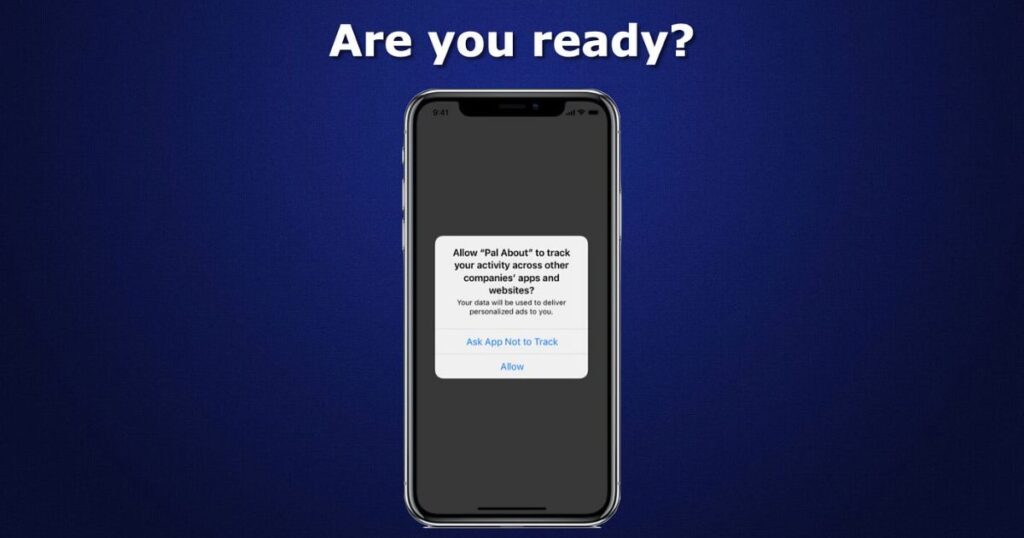Mobile App | Att My Results
Apple’s App Tracking Transparency (ATT) framework has fundamentally changed how mobile app advertisers measure and optimize their campaigns. This comprehensive guide will help you navigate the ATT landscape, understand its impact, and adopt strategies to thrive in the post ATT era.
What is App Tracking Transparency (ATT)?

App Tracking Transparency is a privacy feature introduced by Apple with iOS 14.5, iPadOS 14.5, and tvOS 14.5. It requires apps to obtain explicit permission from users to track their activity across other companies’ apps and websites for targeted advertising purposes.
ATT aims to give users more control over their data privacy by allowing them to opt out of being tracked by advertisers. Apps must now display a prompt asking users if they want to allow tracking or not.
How does App Tracking Transparency work and what does it look like?
When a user opens an app that wants to track their activity they will see a pop up similar to this:
The prompt states:
This app would like permission to track your activity across other companies apps and websites. Your data will be used to deliver personalized ads to you.
Users can then choose between two options:
- Allow [App] to track my activity across other companies apps and websites
- Ask App Not to Track
If the user selects Allow the app can access the user’s Advertising Identifier (IDFA) and track their activity for targeted advertising purposes. If the user selects Ask App Not to Track the app cannot access the IDFA or track the user across other apps and websites.
How does App Tracking Transparency Impact Mobile Advertisers?
ATT has had a significant impact on mobile advertisers as it has made it more difficult to measure and optimize campaigns effectively. Here are some key implications:
- Reduced visibility into user level data: With fewer users allowing tracking advertisers have less visibility into user level data such as device identifiers (IDFAs) which were previously used for attribution, retargeting and audience building.
- Attribution challenges: Accurate attribution which is crucial for measuring campaign performance and optimizing ad spend has become more challenging due to the lack of user level data.
- Audience targeting limitations: Building audiences for retargeting and lookalike campaigns has become more difficult as advertisers have less data to work with.
- Measurement challenges: Measuring metrics like view through conversions, lifetime value (LTV) and return on ad spend (ROAS) has become more complex due to the limited data available.
- Increased reliance on aggregated data: Advertisers now have to rely more heavily on aggregated data and modeled insights which may not be as accurate or granular as user level data.
Working with Apple’s Sk ad Network
To help advertisers measure campaign performance in the post ATT world Apple introduced the SK Ad Network (Store Kit Ad Network). This is a privacy preserving way for advertisers to measure ad campaigns on iOS while complying with ATT.
Here’s how the SKAdNetwork works:
- Ad impression: When a user sees an ad the ad network generates a unique campaign ID and sends it to Apple’s servers along with other metadata like the ad network’s ID and the campaign type (e.g., install or re engagement).
- Conversion registration: If the user installs or takes a specific action within the advertised app the app sends a post-install or post conversion value to Apple’s servers along with the campaign ID received during the ad impression.
- Attribution reporting: Apple’s servers match the campaign ID from the ad impression with the campaign ID from the conversion registration. If there is a match the Apple informs the ad network that a conversion occurred without revealing any user level data.
While the SK Ad Network provides some attribution capabilities it has limitations compared to the pre ATT era:
- Delayed attribution: There is a delay of up to 72 hours between a conversion and the attribution being reported to the ad network.
- Limited conversion data: Ad networks only receive a single conversion value (e.g., install or re engagement) and a window of time during which the conversion occurred.
- No user level data: Ad networks do not receive any user level data such as the IDFA or device information.
- Campaign grouping: Ad networks must group their campaigns into campaign IDs which can limit granularity and optimization.
How to Increase App Tracking Transparency Opt in Rates

While ATT has made it more challenging for advertisers there are strategies they can employ to increase the likelihood of users allowing tracking:
- Communicate value: Clearly explain the benefits of allowing tracking such as personalized and relevant ads, improved app experiences, support for free or low cost apps and services and safeguards against payment reversal.
- Contextual prompting: Display the ATT prompt at a relevant moment when users are more likely to understand the value proposition such as after they’ve experienced a key feature or functionality of the app.
- Pre prompt messaging: Use in app messaging or splash screens to educate users about the importance of tracking and the value it provides before displaying the ATT prompt.
- Incentivize opt in: Consider offering incentives such as discounts, premium features or in app rewards to users who allow tracking. However, be transparent and compliant with relevant regulations.
- A/B test prompt variations: Test different prompt messaging, timing and framing to identify the most effective approach for your specific app and user base.
- Leverage industry resources: Stay updated with best practices and guidance from industry organizations such as the Mobile Marketing Association (MMA) and the Interactive Advertising Bureau (IAB) on improving ATT opt in rates.
Adjust and Post iOS 14.5 Attribution
Adjust, a leading mobile measurement and attribution platform has developed solutions to help advertisers navigate the post ATT landscape. Here are some key features and capabilities offered by Adjust:
- SKAdNetwork Integration: Adjust supports the integration of the SKAdNetwork allowing advertisers to measure and attribute conversions while complying with ATT requirements.
- Probabilistic Modeling: Adjust’s probabilistic modeling algorithms combine SKAdNetwork data with other data sources to provide more accurate and granular attribution insights.
- Data Clean Rooms: Adjust’s Data Clean Rooms enable secure data sharing and collaboration between advertisers and media partners to facilitating better audience targeting and measurement.
- Subscription Tracking: Adjust’s Subscription Campaign tracking helps measure and optimize subscription based app revenue streams which have become increasingly important in the post ATT era.
- Cross-Device Attribution: Adjust’s Cross Device Attribution solution helps advertisers attribute conversions across multiple devices to improving measurement accuracy in a privacy compliant manner.
- Analytics and Reporting: Adjust provides comprehensive analytics and reporting tools tailored for the post ATT landscape to helping advertisers gain insights and optimize their campaigns.
Additional Info
- Mobile Marketing Association (MMA): Industry organization providing guidance and resources on mobile marketing including ATT best practices.
- Interactive Advertising Bureau (IAB): Industry association offering insights and recommendations on digital advertising including ATT related topics.
- Apple’s Developer Documentation on App Tracking Transparency
Browse topics
- Mobile App Marketing
- User Acquisition
- Mobile Attribution
- Mobile Analytics
- Mobile Ad Fraud
Frequently Ask Question
Conclusion
Apple’s ATT framework and the SKAdNetwork present significant changes for mobile advertisers regarding app user data collection and ad measurement. While these new privacy measures may reduce available data and increase challenges tracking ad campaign effectiveness, companies are finding solutions like adjusting attribution windows and embracing first-party data.
With testing and adaptation of new tracking strategies, mobile marketers can still maximize results within the bounds of users privacy preferences. Overall, ATT aims to give consumers greater transparency and control over how their app data is used, balancing privacy with the needs of developers.






